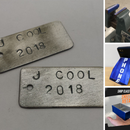Introduction: Metal Barn Star
As I was cleaning up my shop after my students had completed the assigned SHEET METAL BOX and lid project. I noticed we had lots of good usable pieces of scrap metal left over. The scrap was usable size but not for any project that I currently use in my curriculum. There had always been one of these metal stars floating around my shop that was left over from the previous shop teacher so I decided to try and use our left over metal to make one.
These metal barn stars are simple and quick to make. They also provide a more decorative project to practice your sheet metal skills on. Make one for yourself or make one as a gift!
In this Instructable I'm going to walk you through how to make one of these sheet metal barn stars.
Step 1: Video Walkthrough
If you'd rather watch and learn, the video above covers this entire build in a little less than 6 minutes.
Step 2: Tools and Materials
Tools
- Foot Shear or Aviation Shears
- Brake
- Vise
- Spot Welder
- Hammer (Possibly)
- Box Cutter (Optional)
Material
- Paper for template pattern
- Cardboard (optional)
- Sheet Metal (I used 22 Gauge)
- Primer Paint
- Color Paint
- Painters Tape (Optional)
- Sand Paper/Emery Cloth
Step 3: Make Your Template
All five points of your star will be the same. Instead of spending the time doing math, measuring, and marking your lines, make a template and make this step easy. I've provided a PDF of the template I used, if you print the pattern full size on a plain piece of copy paper it will be the correct size.
Once the pattern is printed on paper, use scissors and cut along the lines. You can either use the paper pattern or transfer and cut the template out on something sturdier, like cardboard, as I did for this Instructable.
If you have a laser cutter you can just take the PDF and cut it out directly onto the sturdier material. I haven't used this project in my classes yet, but I'm thinking I might. My thought is I can either cut out a bunch of these templates from plastic. Or, I can go even more in depth and have my students design the template on a CAD software. Then the students can cut their own template out on the laser engraver. My students have seen me working on the star and they seem interested in making one, so I'll have to give this more thought before I turn this into a full on classroom project.
Attachments
Step 4: Trace Template to Metal
Take your template and trace the pattern onto your metal. Repeat tracing your pattern five times for the needed five points of your star. Easy peasy, lemon squeezy!
Step 5: Cut to Shape
With your star pattern on your metal, you now need to cut along the lines to get your final shape. I used my foot shear which allows me to make each cut in one process and leaves each edge of my metal smooth and clean. You can use aviation shears as well but you would then want to use a file to clean up the sharp, jagged edges before continuing on to the next step.
Making each piece of metal as close to the same shape as possible is your goal. The bigger the difference there is from piece to piece, the more difficult the assembly process will be for you. One of my pieces for my first star was just ever so slightly different than the others. When I went to attach all the pieces together that difference really caused me fits with getting each point attached in the proper position. That difference in pieces left my finished star with a small open gap at the center. (My hammer came in handy when closing that small gap to salvage that star, otherwise I would have scrapped it and started fresh)
Step 6: Mark Lines
Using a template in the previous step to cut the metal to shape leaves you only two lines left that need to be marked for bending. In the location where your tab needs to be, measure perpendicular from the edge of your metal in 1/2 of an inch. Then, use your 1/2" mark and the bottom point as reference to mark your tab line. Next, take a straight edge and line it up from top point to bottom point and mark a line. Repeat that process for all of your pieces.
Step 7: Bend
This portion of the project is more art than science. The first bend you want to make is along your center line. I used my brake to bend each piece until it looked and "felt" right. I'd guess that the bend should be somewhere between 50 to 70 degrees.
The tab has to be bent in the opposite direction of your first bend. I couldn't figure out a good way to bend the tab in my brake so I used a vise. Clamp down with your vise jaws on your tab line and use a little bit of force to bend the tab with your hands. Again, I'm not sure of the exact angle, just bend until the tab looks right. Make all the tab bends roughly the same and then work them into the right position when you spot weld.
I found the goal for this step is just bending all of your pieces relatively the same. I had to lightly rework/rebend some of my parts by hand to position them into place as I attached them together. Most of the parts fit together pretty well but the last piece can be a real challenge. Shoot for similar looking pieces but don't fret if they don't all look exactly the same.
Step 8: Spot Weld
Time to create some star power! Clean up your tabs with some sand paper or emery cloth. This is especially important if you used layout fluid. When cleaning up your tabs your goal is trying to make your tabs look shiny without any paint, rust, or oil on them. Once the tabs are cleaned, grab two of your pieces, tuck the tab of one of your pieces behind the other. Be sure that the pieces are sitting flush with each other. You should not be able to see much of the tab between the two pieces. Hold your pieces in that position and spot weld them together. Three spot welds across the tab seem to work pretty well for me. Lather, rinse, and repeat that process until you have your five point star fully assembled.
The last piece is always the most difficult to get in the right spot. For the example pictured above I ended up having to cut the tab of the last piece back away from the center about half an inch to make it fit together. Once my star was fully assembled I had a small gap right in the center where all the pieces met that I wasn't a fan of. I used a hammer to lightly tap the center portion together which closed the gap to what I considered an acceptable amount. Overall, just take your time and don't get to frustrated if the star isn't perfect. It's supposed to look a little rustic so people will think you meant to have it look the way it ends up.
Step 9: Paint
Time to add a little color to your work. If you haven't already, give your star a light sanding front and back to prepare for painting, move to a well ventilated area, and paint away!
On any decorative project, like this star, I always start with a primer coat of paint first. In this case that primer coat was plain white. If you are just going to paint your star one color, after the primer coat, apply a coat of your chosen color, wait for that coat to dry, and you're finished. I wanted to try making a simple 4th of July, red/white/blue color scheme for one of my stars. After my primer coat, I taped off portions of my star to get the desired look and then painted blue. Then repeated that taping process for the red section. Be as creative as you want, take your time, and it should come out looking great!
If you get any runs in your paint be sure to sand them off before applying another layer of paint.
Step 10: Display!
Display your work proudly!
These stars can be a great decoration for your home or they can also make great gifts!
After working through making these stars I think I will end up using this project in my classes next school year. They are simple to make and I was able to make all of my stars for this Instructable from scrap metal I had left over from other projects. These metal stars will also give students an opportunity to be a little more creative than with a normal beginner project in my class by having the students choose their own paint scheme, which I'm always a fan of with my classroom projects.
If you make a star, let me know!
Enjoy creating and learning!





